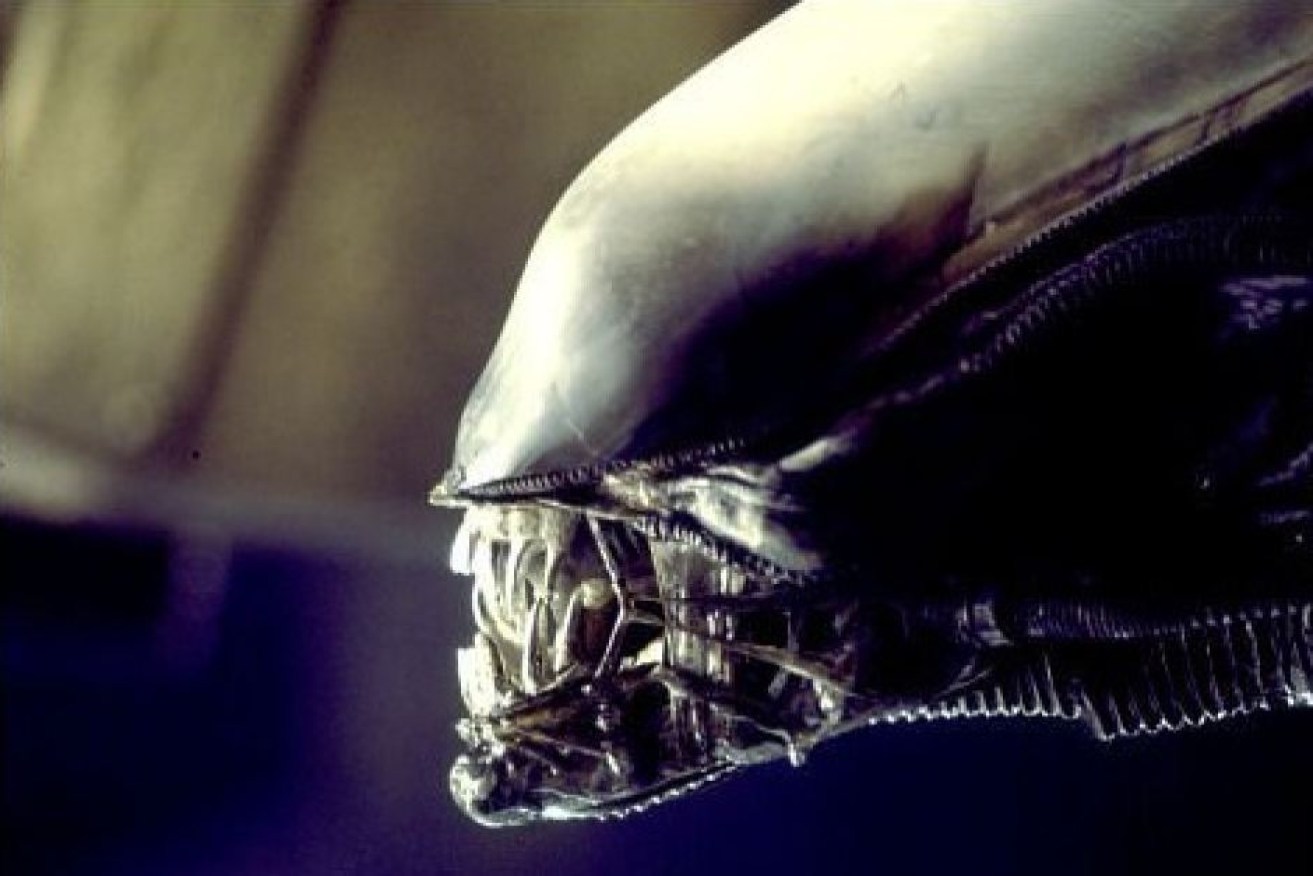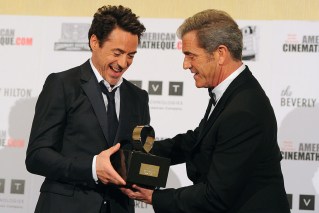Ridley Scott’s Alien the subject of documentary Memory: Origins of Alien

The xenomorph first appeared in the 1979 film Alien. Photo: Twentieth Century Fox/Robert Penn
It’s been 40 years since Alien burst through the chest of unsuspecting movie audiences in the summer of 1979, launching the careers of director Ridley Scott and breakout star Sigourney Weaver, and minting an eight-film-and-counting franchise that’s proved harder to extinguish than a xenomorph terrorising a hapless freighter crew.
In space, no one may be able to hear you scream, but that hasn’t stopped a cottage industry of boffins, fans and chin-stroking academics yapping about Alien and its many iterations across four decades.
The discussion gets another workout in Alexander O Philippe’s new documentary Memory: The Origins of Alien, which traces the genesis of the film in cinema history and cultural myth, alongside well-told tales of the project’s production.

Francis Bacon’s 1944 painting Three Studies for Figures at the base of a Crucifixion inspired the design of the “chestburster” creature. Supplied: Courtesy of the O’Bannon Estate
Exploring Alien from its beginnings in screenwriter Dan O’Bannon’s mind, to the visionary influence of Swiss biomech artist HR Giger — who designed the infamous alien and its nightmarish home world — and the galvanising presence of Scott, the film weaves a thread of cultural myth through the science fiction classic, to mostly fascinating, if sometimes familiar effect.
Philippe makes this intention clear with a fictional prelude set at Delphi’s Temple of Apollo, during which the three Furies of Greek of Myth emerge from the primordial slush like alien larvae in the static vision of a space crew’s view-finder.
“Awake my goddesses,” beckons an overwrought voiceover, “a dream is calling”.

The start of Memory: The Origins of Alien features the three Furies of Greek Mythology. Supplied: Madman Entertainment
That dream turns out to be a conventional talking heads format, as a grab-bag assortment of experts, from podcasters and academics to authors and TV hosts, deliver theories and offer up ready-made remarks like “cinema is a window on our collective unconscious”.
Scott and Weaver are nowhere to be found, relegated to archival interview clips alongside the late O’Bannon, Giger, and co-star John Hurt, though actors Tom Skerritt, Veronica Cartwright, and various members of the production team — including editor Terry Rawlings, producer Ivor Powell, and co-story-writer Ronald Shusett — drop by to reflect.
It’s O’Bannon’s wife, Diane, who proves to be a useful custodian of the film’s early legacy. She helps sketch her husband’s formative period as a comic-book-reading Midwestern boy living through the Cold War paranoia of the 1950s, where the future Alien writer helped his dad stage a fake UFO sighting and was, among other things, petrified of insects.

In the 1970s, O’Bannon was contracted to work on special effects for Alejandro Jodorowsky’s production of Dune. Supplied: Courtesy of the O’Bannon Estate
“These things gave him the creeps,” she recalls. “And he wanted to creep everyone else out, too.”
Aided by montages of O’Bannon’s youthful illustrations and writing, the film locates the early sparks of Alien in the artist’s lifelong obsession, like his love for a 1951 Weird Science comic, Seed of Jupiter (which seems to be ground zero for the chest-burster), the influence of HP Lovecraft’s At the Mountains of Madness, and movies like The Thing From Another World (1951), It! The Terror From Beyond Space (1958), Planet of the Vampires (1965) and Queen of Blood (1966).
Fans of Alien will be familiar with much of this, as they will the film’s well-trod journey to the screen, also reiterated here: O’Bannon’s dry-run collaboration with John Carpenter on Dark Star, his brief partnership with Alejandro Jodorowsky on the never-realised Dune, and the film’s acquisition by 20th Century Fox and producer Walter Hill — when it still went by the Roger Corman-esque title of Star Beast.

A pencil drawing of the iconic “xenomorph” from Ridley Scott’s 1979 film Alien. Supplied: Courtesy of the O’Bannon Estate
Alien’s path to the screen is covered extensively on Fox’s behind-the-scenes documentaries, including The Beast Within: The Making of Alien, widely available on the 2003 DVD set. Memory works best as a supplement — a look at the cultural history that allowed this perfect science fiction storm to happen.
When Memory breaks from the familiar it suggests something more compelling: Alien as a result of hundreds, even thousands of years of cultural fears and anxieties cooked into the DNA of the finished product.
The cultural lighting rod for this seems to have been the work of Giger, whose wonderfully grotesque design synthesised everything from Hieronymus Bosch to ancient Egyptian mythology — especially its obsession with the realm beyond death — with his own whacked-out vision, and who painted, according to his old friend, in a trance as though possessed.

A scene featuring the Temple of Apollo ruins in Delphi, Greece. Supplied: Madman Entertainment
Particularly fascinating is a passage exploring Francis Bacon’s influence on the alien chest-burster, how its tiny, gnashing teeth and reptilian phallus were inspired by the painter’s Three Studies for Figures at the Base of a Crucifixion — and indirectly, Bacon’s own resentment at his father for disowning him upon discovering his homosexuality.
Similarly, the film touches on Alien’s more widely discussed themes around male anxiety of childbirth and penetration, and the fear of the monstrous feminine that finally manifests in that infamous scene — during which the newborn alien took several messy attempts to burst through the t-shirt of John Hurt’s prosthetic double.
Hello my baby, hello my darlin’ — hello to centuries of repressed femininity, here to avenge the patriarchy via a blood-splattered puppet.

Actor Tom Skerritt (Top Gun) played Captain Dallas of the Nostromo in Alien. Supplied: Madman Entertainment
The film is considerably less convincing when it attempts to paint Alien as a metaphor for, say, the disintegrating American family, or likens the mysterious xenomorph to the emergence of serial killers (a fun reach, to be sure), though it does makes the keen observation that — with its anti-imperialist undertow and spaceships named for Joseph Conrad’s Nostromo and Narcissus — Alien paralleled Apocalypse Now (1979), Francis Ford Coppola’s account of a doomed crew sent up a claustrophobic river to slay another monster.

Growing up, Alien co-writer Dan O’Bannon was a fan of comics, science-fiction and horror. Supplied: Courtesy of the O’Bannon Estate
But perhaps Memory’s most curious aside involves Ridley Scott himself, a man who has returned to this franchise in his later career with an obsessiveness that transcends even the diminished creative results. (It’s telling that Fox had originally wanted to lose the “Space Jockey” sculpture because it had no narrative function, only for Scott to insist it stay.)
Is Scott revisiting the Alien well as a means of exploring his own mortality, courting the possibility that his legacy might be seeded by the ancient chariots of the gods? It’s a large part of why Alien continues to fascinate — it’s built around this primal, even divine creation that endures despite our feeble attempts to snuff it out; a life-force that thrives, even as it threatens mankind’s destruction.
Memory: Origins of Alien is in cinemas now.








